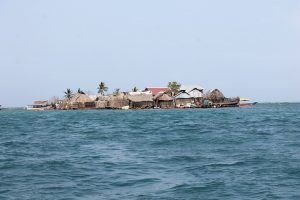The Guna, the inhabitants of the archipelago Guna Yala of Panama, in the Caribbean, have all the chances to be among the first displaced people by climate change of the planet. The sea could eat its 30 islands and 400 islets. Since the 1950s, the waters of the Caribbean have grown between 20 and 25 centimeters. Growth has been fastest since 2012.
Diwigdi Valiente, being a Guna himself, spotted the problem a few years ago. He had returned from a congress in Dublin, Ireland, and embarked on the venture of addressing the problem within his community, as writes Rocío Aguilera for El País. He called himself “the warrior against climate change.”
Valiente is from Playón Chico, the second largest island in the archipelago, where some 4,000 people live. He studied Hospitality and International Business in Switzerland and Fashion Design in Spain. He did a master’s degree in Economics and Finance. But he also has a vocation for artistic expression.

His ease of travel has allowed him to undertake and complete the pieces of the conversation between what international experts say about climate change and the living testimonies of the problem on his own island.
In 2016, he launched a project to raise awareness through the arts. Since then, he has brought together artists from different areas to work with the children. That’s why the project is called Burwigan, which in the Dulegaya language, the one spoken by the Guna, means “children”.
” These kids are the ones who have the power to change negative patterns in our society and protect our environment,” says Valiente in the presentation of the project on its website.
“What we do is to bring artists who carry out different workshops together with the community, with the children, with the teachers and the women to raise awareness about how climate change is going to affect them in the coming years,” he adds, quoted by Rocío Aguilera.
Artists from several countries have visited Playón Chico to do workshops for several days.
They have held workshops with up to 80 children, as well as exhibitions of their work, with plastic, cans and waste that they recycle into art. In one, for example, they made sculptures with plastic in the form of fish. They put them next to buildings, houses and palm trees, to show how high the sea level would grow in the coming decades.
The Guna Yala archipelago, also known as the San Blas archipelago, is one of the Caribbean’s favorite tourist destinations. It operates as as an autonomous community.

The Gunas came to these islands more than 150 years ago from the mainland. They used to live in the Colombian jungles, when Panama was not yet a nation.
Since they have neither fresh water nor fertile land for growing food, as chronicler Ander Izaguirre points out in another article for El País in 2014, the Gunas live between the two worlds: from the sea they are supplied by fishing and tourists are transported to the islets; on the continent, where they frequently pass by, they have their crops, use the water of the rivers and bury their dead.
Steve Paton, of the Smithsonian Institute, showed these data to Ignacio Fariza, also for El País: between 1950 and 1980, the Caribbean rose an average of 2.5 millimeters per year, and since 2012 it has increased to 6.4 millimeters per year. That means that, for example, one of the main islands of the archipelago, Gardi Surgup, has lost a third of its shore. If we continue like this, at the end of the 21st century the sea could rise at a rate of 10 millimeters per year.
Rising sea levels are not the only threat to the Guna Yala. There is a change in rainfall patterns due to rising air and sea temperatures, leading to more storms and more dry seasons.
“The rise of the sea also threatens the main sources of income of the population, with an economy dependent on items such as tourism and artisanal fishing. For example, there have been changes in the volume and species of fish and schools of fish are moving away from the islands and out to sea,” added Jessica Young, national manager of the national manager of the United Nations Development Program (UNDP) for environment and sustainable development issues, in a press release from UNDP Panama.
Several consulted reports agree that in the inhabited islands of Guna Yala there are problems of overcrowding and basic services and insufficient waste management.
The Guna’s passage to the mainland is now seen as an urgent measure. BBC Mundo reported in 2017 that the inhabitants of Gardi Sugdub Island had 17 hectares reserved on the other side, the mainland, to build a town called La Barriada. “November and December the rains and the strong winds came, all flooded,” said Dalis, a teacher on the island, who was leading the relocation project.
In this year’s report to El País, Ignacio Fariza wrote that the little more than 1,000 inhabitants of another island, Cangrejo Island, are already preparing to move to the mainland.
This could be a pilot program for the rest of the islands, he reported. “In the months of trade winds, the water has always come in, but more and more is coming in. And the winds come every time before,” said Blas Lopez, one of its inhabitants.
According to Fariza, the Panamanian government is preparing for the transfer of several Guna communities, in coordination with the archipelago’s highest authority, the General Guna Congress and the local chiefs, known as “saglas.”
With its Burwigan project, Diwigdi Valiente hopes to continue adding government agents and private enterprise, galleries, cultural centers, embassies “to take our message to the whole world” and also raise funds to move his neighbors from Playón Chico to the mainland. For the time being, they are organizing a fundraising campaign to build a story telling center in the local school
